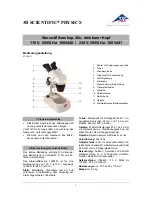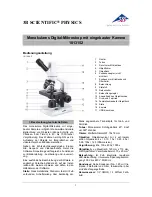
SETTING UP YOUR MICROSCOPE
(CONTINUED)
7. Plug the AC adapter into the socket on the back of the base (8).
8. Insert the plug end of the AC adapter into the proper power
source.
Additionally the microscope can be powered with three AA
batteries.
- Open the battery compartment on the base (8) of the microscope.
- Install the three AA batteries (supplied) and close the battery
compartment.
MICROSCOPE OPERATION
Before viewing specimens, please read these sections
thoroughly regarding focusing, changing power (magnification),
using the stage and adjusting illumination.
VIEWING A SPECIMEN
Carefully place a specimen slide under the stage clips (5) and
center the specimen. Images will be observed upside down and
reversed right to left. Prepared slides are included with your
microscope to help you get started.
You are now ready to focus and view a specimen. Be careful not
to damage the specimen slide. When using higher powers while
focusing, make sure the objective lens (4) does not hit the slide or
object being viewed.
FOCUSING AND CHANGING POWER
(MAGNIFICATION)
1. Always start with lowest power (4x objective lens and WF 10x
eyepiece). This combination yields the lowest power.
2. Place a specimen slide (or object) on the stage (6) directly under
the objective lens (4). Gradually turn the focus knob (11) until
the specimen is in focus.
3. For higher powers, rotate the nosepiece (3) to change the
objective lens (4) to 10x or 40x. This will yield a greater
magnification. Gradually turn the focus knob (11) to refocus on
the specimen.
NOTE:
You should first turn the focus knob to lower the stage,
before turning the objective carriage.
ADJUSTING THE ILLUMINATION
Specimens of different sizes, thickness and color variations will
require different levels of illumination. In order to adjust illumination,
turn the illuminator adjustment wheel (14) to either increase or
decrease the illumination. The illuminator adjustment wheel (14) has
three illumination settings (I being the lowest and III the highest).
Optimal lighting is found by making adjustments and experimenting.
DIAPHRAGM
The disc diaphragm (12) has six diameter openings. These
openings allow you to adjust the amount of light passing through
the specimen. Adjusting the light can help you maximize brightness,
contrast, etc.
CARE, MAINTENANCE AND WARRANTY
Your Celestron Labs microscope is a precision optical instrument
and should be treated with care at all times. Follow these care and
maintenance suggestions and your microscope will need very little
maintenance throughout its lifetime.
• When you are done using your microscope, remove any
specimens left on the stage.
• Turn off the power and unplug the power cord (if applicable).
• Always place the plastic bag or dust cover over the microscope
when not in use to help keep it clean.
• Store the microscope in a dry, clean place.
• Be very careful if using your microscope in direct sunlight to
prevent damage to the microscope or your eyes.
• To carry your microscope, place one hand on the “arm”(10) of the
microscope and the other hand under the base for support. Do not
grasp your microscope by the focuser knob or head.
• Clean the outside surfaces (metal and plastic) with a moist cloth.
• Always unplug any cords before cleaning.
• Never clean optical surfaces with cloth or paper towels as they
can scratch optical surfaces easily. Instead, use an air blower or
camel hair brush.
• To clean fingerprints off of optical surfaces, use a lens cleaning
agent and lens tissue available at most photo supply stores.
When cleaning, do not rub in circles as this may cause streaks or
scratches.
• Never disassemble your microscope or clean internal optical
surfaces. Only qualified technicians at the factory or an authorized
repair facility should attempt these repairs.
• When handling glass specimen slides, use care, as the edges can
be sharp.
USING THE SMARTPHONE ADAPTER
Note: large smartphone cases should be removed from the
smartphone before being fitted into the smartphone adapter. Some
very large “ultra” or “plus” smartphones may be too large for use.
1. Pull outward on the spring clamp arms and place the smartphone
into the space between the clamp arms so that it is securely
grasped by the tension of the arms.
2. Loosen the smartphone clamp position knob (if not already loose)
and position the eyecup of the adapter so that its aperture aligns
with the camera lens of the smartphone.
3. Tighten the smartphone clamp position knob and check that the
position of the adapter’s eyecup aperture stays centered over the
smartphone camera lens.
4. Slide the eyecup cuff over the eyepiece of the microscope.
5. Activate the smartphone camera and check that the image seen
through the microscope is centered in the smartphone’s viewing
screen. If it is not, use the adapter’s clamp position knob to make
adjustments until it is. NOTE: the image will be vignetted (shows
as a circle inside a black border area) - this is normal. Simply use
the smartphone camera’s zoom to expand the image until the
vignetting disappears.






















